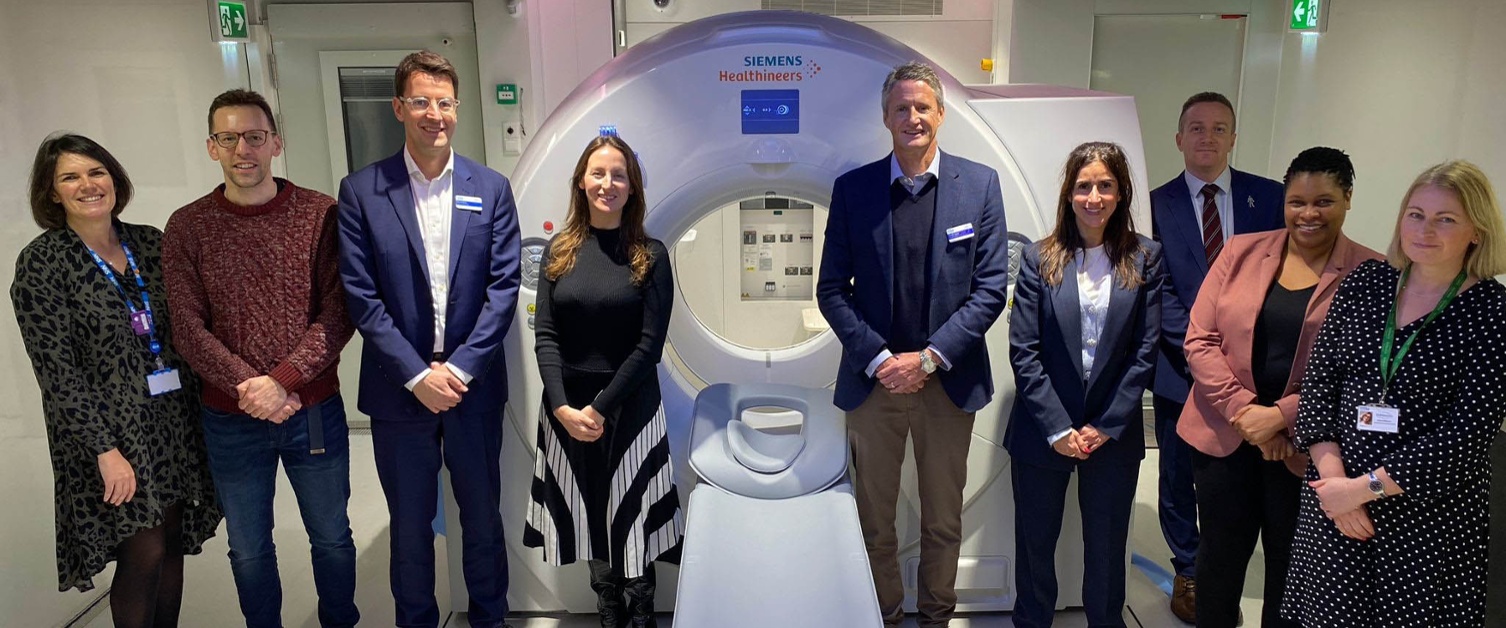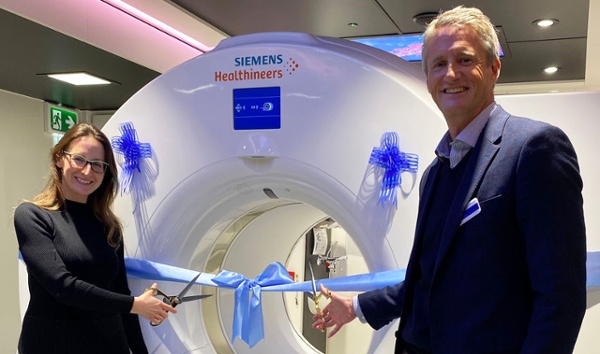New and improved specialised scanner seeing more patients than ever at Singleton Hospital

A highly specialised scanner used to diagnose cancer and other conditions is seeing more patients than ever at Swansea’s Singleton Hospital.
The mobile PET-CT scanner service was introduced there in 2020 and meant people from Swansea Bay and further west no longer had to travel to Cardiff to be scanned.
Now, less than four years later, InHealth, the private healthcare company that provides the service on behalf of the NHS, has replaced the existing scanner with a new and more sophisticated version.
Above: The new PET-CT scanner is officially opened
And with the number of patients increasing year-on-year, there are longer-term plans to establish a static PET-CT scanner within the hospital building, which will bring further benefits.
 Professor Neil Hartman, Head of Nuclear Medicine, said there was previously no PET-CT scanning capability this side of Cardiff, meaning patients from Swansea Bay and West Wales had to travel to the capital.
Professor Neil Hartman, Head of Nuclear Medicine, said there was previously no PET-CT scanning capability this side of Cardiff, meaning patients from Swansea Bay and West Wales had to travel to the capital.
That was until the mobile scanner, located in a large unit immediately outside the hospital, opened in July 2020.
Pictured: Swansea Bay radiologist Dr Victoria Trainer and InHealth Chief Executive Officer Geoff Searle cut the ribbon at the launch event
“We expected to see around 1,200 patients during the first year,” said Professor Hartman.
“We have been very busy since then and we are now scanning roughly 2,000 patients a year, with the PET-CT scanner available for use three days a week – Monday, Tuesday and Wednesday – instead of the original two days.
“Demand is rising by around 20 per cent a year. But new uses for PET are also being approved every year so that takes it closer to 30 per cent.”
A PET-CT scan combines CT (computed tomography) and PET (positron emission tomography) scans.
The CT scan takes X-rays of the body to create a 3D anatomical picture. The PET scan involves injecting a radioactive drug and then scanning its location within the patient’s body.
This shows up areas where cells are consuming more glucose than normal. It can reveal cancer and some other diseases which may not show up on other types of scans.
Its accuracy means it can diagnose cancer, find out how big a cancer is and whether it has spread.
It can also show how well a cancer has responded to treatment, whether it has come back, and if so, exactly where it is.
Additionally, PET-CT scans can identify other diseases which may not show up on other types of scans such as dementia and myocardial disease.
The service at Singleton is funded by the Welsh Health Specialist Services Committee (WHSSC), which ensures fair access to a full range of specialist services for the population of Wales.
The scanner is used predominantly for cancer, along with pyrexia of unknown origin, a persistent fever lasting for more than three weeks with no identified cause, as well as dementia and cardiac conditions.
Professor Hartman said the health board had a long-standing and valued relationship with InHealth.
“We would not usually expect a scanner to be replaced for seven to 10 years but we are extremely fortunate that InHealth offered the new version to us to reflect that relationship,” he added.
 Among the benefits of the upgraded mobile unit (left), which includes the very latest PET-CT scanner, is a large and open design, supporting patients who may be claustrophobic, with visual displays in the ceiling.
Among the benefits of the upgraded mobile unit (left), which includes the very latest PET-CT scanner, is a large and open design, supporting patients who may be claustrophobic, with visual displays in the ceiling.
There are individual patient uptake bays to support privacy and confidentiality, along with a TV in each bay.
There are also two lifts for patients with a range of mobilities and for in-patients who need to be brought in by stretcher.
While these benefits are undoubtedly welcome, Professor Hartman said a priority shared by Swansea Bay, WHSSC and the Welsh Government was for a static PET-CT scanner to be established within the hospital.
“A static PET-CT centre typically has more uptake rooms, so you can increase the patient throughput,” he said. “You could do radiotherapy planning with lasers, which you cannot do on a mobile scanner.
“You can do paediatrics, general anaesthesia patients and cardiac PET studies on a static scanner, none of which are possible on a mobile scanner. So there are lots of benefits and we are developing our plans to hopefully have this introduced in the next few years.”
Rydym yn croesawu gohebiaeth a galwadau ffôn yn y Gymraeg neu'r Saesneg. Atebir gohebiaeth Gymraeg yn y Gymraeg, ac ni fydd hyn yn arwain at oedi. Mae’r dudalen hon ar gael yn Gymraeg drwy bwyso’r botwm ar y dde ar frig y dudalen.
We welcome correspondence and telephone calls in Welsh or English. Welsh language correspondence will be replied to in Welsh, and this will not lead to a delay. This page is available in Welsh by clicking ‘Cymraeg’ at the top right of this page.